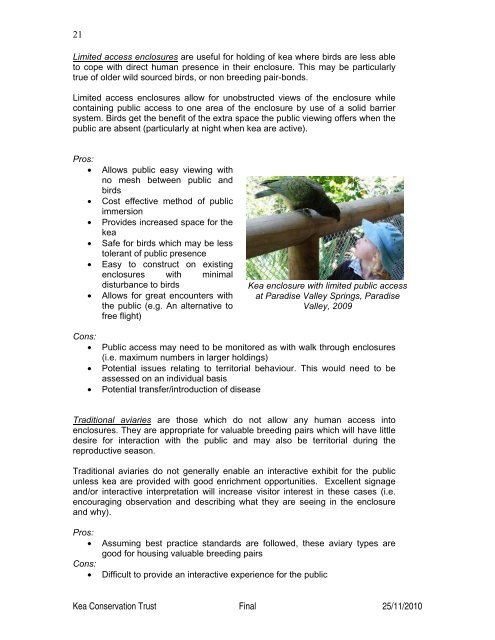(Nestor notabilis) Husbandry Manual - Kea Conservation Trust
(Nestor notabilis) Husbandry Manual - Kea Conservation Trust
(Nestor notabilis) Husbandry Manual - Kea Conservation Trust
You also want an ePaper? Increase the reach of your titles
YUMPU automatically turns print PDFs into web optimized ePapers that Google loves.
21<br />
Limited access enclosures are useful for holding of kea where birds are less able<br />
to cope with direct human presence in their enclosure. This may be particularly<br />
true of older wild sourced birds, or non breeding pair-bonds.<br />
Limited access enclosures allow for unobstructed views of the enclosure while<br />
containing public access to one area of the enclosure by use of a solid barrier<br />
system. Birds get the benefit of the extra space the public viewing offers when the<br />
public are absent (particularly at night when kea are active).<br />
Pros:<br />
• Allows public easy viewing with<br />
no mesh between public and<br />
birds<br />
• Cost effective method of public<br />
immersion<br />
• Provides increased space for the<br />
kea<br />
• Safe for birds which may be less<br />
tolerant of public presence<br />
• Easy to construct on existing<br />
enclosures with minimal<br />
disturbance to birds<br />
• Allows for great encounters with<br />
the public (e.g. An alternative to<br />
free flight)<br />
<strong>Kea</strong> enclosure with limited public access<br />
at Paradise Valley Springs, Paradise<br />
Valley, 2009<br />
Cons:<br />
• Public access may need to be monitored as with walk through enclosures<br />
(i.e. maximum numbers in larger holdings)<br />
• Potential issues relating to territorial behaviour. This would need to be<br />
assessed on an individual basis<br />
• Potential transfer/introduction of disease<br />
Traditional aviaries are those which do not allow any human access into<br />
enclosures. They are appropriate for valuable breeding pairs which will have little<br />
desire for interaction with the public and may also be territorial during the<br />
reproductive season.<br />
Traditional aviaries do not generally enable an interactive exhibit for the public<br />
unless kea are provided with good enrichment opportunities. Excellent signage<br />
and/or interactive interpretation will increase visitor interest in these cases (i.e.<br />
encouraging observation and describing what they are seeing in the enclosure<br />
and why).<br />
Pros:<br />
• Assuming best practice standards are followed, these aviary types are<br />
good for housing valuable breeding pairs<br />
Cons:<br />
• Difficult to provide an interactive experience for the public<br />
<strong>Kea</strong> <strong>Conservation</strong> <strong>Trust</strong> Final 25/11/2010












